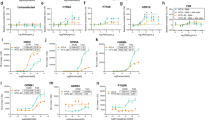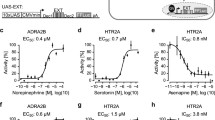Abstract
Ligand-biased signaling could have a significant impact on drug discovery programs. As such, many approaches to screening now target a larger section of the signaling responses downstream of an individual G protein-coupled receptor (GPCR). Biosensor-based platforms have been developed to capture signaling signatures. Despite the ability to use such signaling signatures, they may still be particular to an individual cell type and thus such platforms may not be portable from cell to cell, necessitating further cell-specific biosensor development. We have developed a complementary strategy based on capturing receptor-proximal conformational profiles using intra-molecular BRET-based sensors composed of a Renilla luciferase donor engineered into the carboxy-terminus and CCPGCC motifs which bind fluorescent hairpin biarsenical dyes engineered into different positions into the receptor primary structure. Here, we discuss how these experiments can be conducted and combined with CRISPR/Cas9 genome editing to assess specific G protein-dependent and -independent events.
Access this chapter
Tax calculation will be finalised at checkout
Purchases are for personal use only
Similar content being viewed by others
References
Sauliere A et al (2012) Deciphering biased-agonism complexity reveals a new active AT1 receptor entity. Nat Chem Biol 8(7):622–630
Beautrait A et al (2017) A new inhibitor of the β-arrestin/AP2 endocytic complex reveals interplay between GPCR internalization and signalling. Nat Commun 8:15054
Namkung Y et al (2016) Monitoring G protein-coupled receptor and β-arrestin trafficking in live cells using enhanced bystander BRET. Nat Commun 7:12178
Besserer-Offroy E et al (2017) The signaling signature of the neurotensin type 1 receptor with endogenous ligands. Eur J Pharmacol 805:1–13
Bourque K et al (2017) Distinct conformational dynamics of three G protein-coupled receptors measured using FlAsH-BRET biosensors. Front Endocrinol (Lausanne) 8:61
Devost D et al (2017) Conformational profiling of the AT1 angiotensin II receptor reflects biased agonism, G protein coupling, and cellular context. J Biol Chem 292(13):5443–5456
Sleno R et al (2017) Conformational biosensors reveal allosteric interactions between heterodimeric AT1 angiotensin and prostaglandin F2α receptors. J Biol Chem 292(29):12139–12152
Sleno R et al (2016) Designing BRET-based conformational biosensors for G protein-coupled receptors. Methods 92:11–18
Machleidt T, Robers M, Hanson GT (2007) Protein labeling with FlAsH and ReAsH. Methods Mol Biol 356:209–220
Hoffmann C et al (2010) Fluorescent labeling of tetracysteine-tagged proteins in intact cells. Nat Protoc 5(10):1666–1677
Grundmann M et al (2018) Lack of β-arrestin signaling in the absence of active G proteins. Nat Commun 9(1):341
Stallaert W et al (2017) Purinergic receptor transactivation by the β2-adrenergic receptor increases intracellular Ca(2+) in nonexcitable cells. Mol Pharmacol 91(5):533–544
O’Hayre M et al (2017) Genetic evidence that β-arrestins are dispensable for the initiation of β2-adrenergic receptor signaling to ERK. Sci Signal 10(484). https://doi.org/10.1126/scisignal.aal3395
Milligan G, Inoue A (2018) Genome editing provides new insights into receptor-controlled signalling pathways. Trends Pharmacol Sci 39(5):481–493
Acknowledgements
The work was funded by a grant to TEH from the Canadian Institutes for Health Research (MOP-130309). KB was supported by an internal Faculty of Medicine Studentship from McGill University.
Author information
Authors and Affiliations
Corresponding author
Editor information
Editors and Affiliations
Rights and permissions
Copyright information
© 2019 Springer Science+Business Media, LLC, part of Springer Nature
About this protocol
Cite this protocol
Bourque, K., Devost, D., Inoue, A., Hébert, T.E. (2019). Combining Conformational Profiling of GPCRs with CRISPR/Cas9 Gene Editing Approaches. In: Tiberi, M. (eds) G Protein-Coupled Receptor Signaling. Methods in Molecular Biology, vol 1947. Humana Press, New York, NY. https://doi.org/10.1007/978-1-4939-9121-1_9
Download citation
DOI: https://doi.org/10.1007/978-1-4939-9121-1_9
Published:
Publisher Name: Humana Press, New York, NY
Print ISBN: 978-1-4939-9120-4
Online ISBN: 978-1-4939-9121-1
eBook Packages: Springer Protocols




